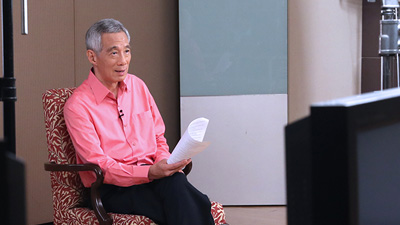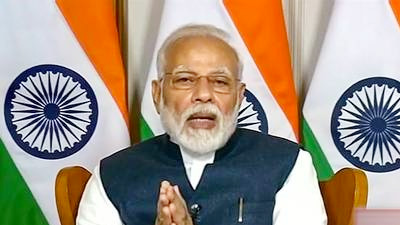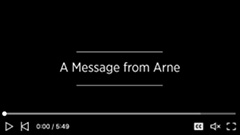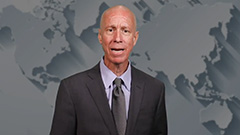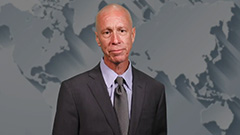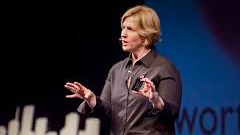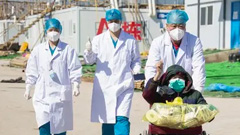Download your free guide to crisis communication by clicking on the image below
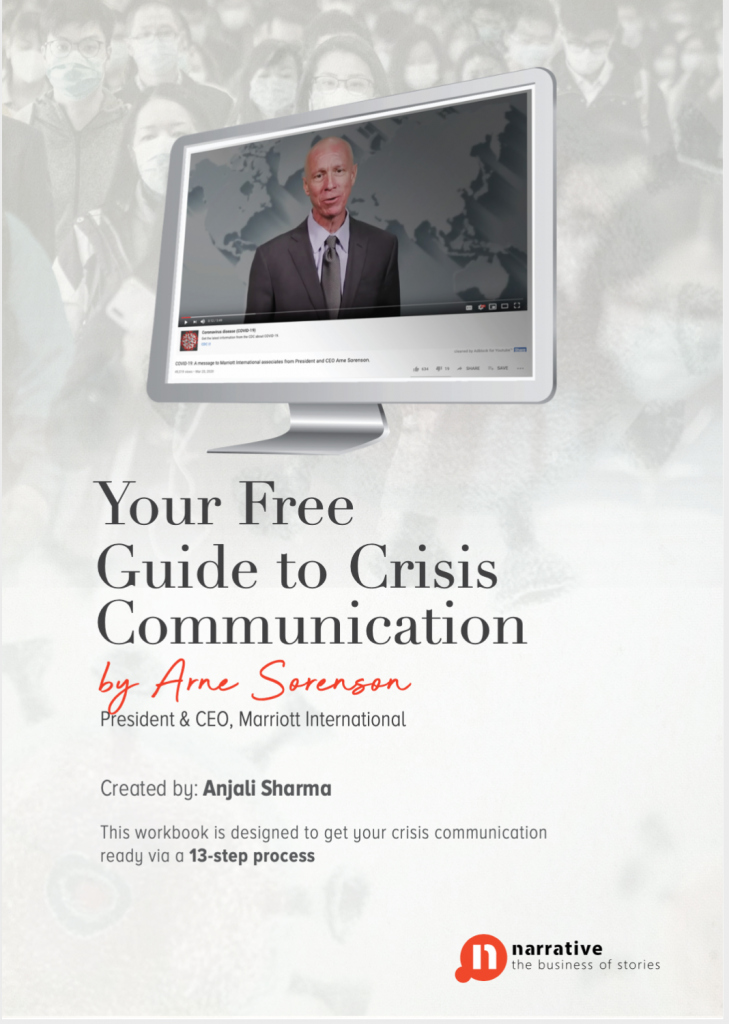
Marriott International President and CEO, Arne Sorenson has unintentionally given every leader who is having to lead in uncertain times a code to communicate in a crisis.
A communication insight I have developed for these troubled times is that not saying anything, is saying everything about your leadership. When people feel the pain, they need the leader’s presence the most, irrespective of whether the leader is delivering good news or bad news, they just want to see their leader face to face telling them exactly how it is. In the unusual case of the COVID-19 outbreak, face-to-face communication is best replaced by a video.
The need to communicate effectively in troubled times is an important one for me because of a personal experience. My father passed away in 2008 and the thing that I remember the most about the month before his death is the fear of unknown.
There were times I felt that if the doctors just told me that he will not survive I would manage it better than managing their silence.
As COVID -19 is engulfing so many of our lives I am carefully observing the leadership communication styles surfacing in these trying times.
When PM Lee in Singapore addressed the nation on the 8th February, I was so happy that I called my husband and said,
“when you fear the unknown and someone of his calibre and credibility speaks – you trust.”
Sure enough, PM Lee’s message calmed the entire nation despite him not sugar coating anything and he received global recognition for showing up for his people.
Here are some hard facts mentioned by him from both his addresses to the nation on 8th February and 12th March.
“But in the last few days, we have seen some cases which cannot be traced to the source of infection. These worried us, because it showed that the virus is probably already circulating in our own population. Right now, we are continuing to do contact tracing and to quarantine close contacts. But I expect to see more cases with no known contacts in the coming days. So our numbers have not blown up. But neither have we been able to eradicate the virus, despite our best efforts.”
“And unlike SARS, this outbreak will continue for some time – a year, and maybe longer.”
“But we too face a serious situation. We expect more imported cases, and therefore new clusters and new waves of infection, this time coming from many countries rather than one or two.”
“Our economy is taking a big hit.”
“The situation is especially serious for some sectors – hotels, aviation, hospitality, and freelancers in the gig economy. But nobody has been spared. Everyone feels the impact, to different degrees.”
“We will remain in this high risk state, nevertheless, for some time to come.”
As we can see he is not trying to say it is all fine, but communicating exactly how it is. What matters is, he shows up and as a result people trust him.
Following suit on 19th March, Prime Minister of India, PM Modi also addressed the nation which I know had a huge positive impact on the psychology of the nation.
As I witnessed the political leaders who want to lead with courage in troubled times showing up, I wondered when will a corporate leader show up? And then on 19 March itself we had the CEO of Marriott Hotel Arne Sorenson share an honest, vulnerable, emotional and hopeful message. Arne Sorenson did not just lead by example but also created a code for authentic leadership communication during the crisis. Here is a breakdown on why his communication worked despite it being a bad news. To make it easy for you to read and comprehend the decode to his 5 mins plus video. I have divide the entire communication in 3 broad sections
Watch the full video here:
SECTION 1: CONTEXT
0 to 0:02 Sec : A message from Arne : Positioning
The video opens with a text, A message from Arne
Notice how the video is not cluttered with information like, A message from CEO of Marriott International, a Marriott logo, music, motion graphics etc. Removing traditionally used video editing and enhancing elements like music, motion graphics etc is a good way to respect the sensitivity of the situation and ensure an authentic message doesn’t look produced during crisis.
The use of the CEO’s first name is a way to bring people closer to the person in the video message. Like a family member or a friend is personally sending you this message.
Lesson: Don’t try to create heavily produced videos for crisis communication. Be clear that the video is from someone in particular. Not Marriott’s message to its employees but Arne’s message.
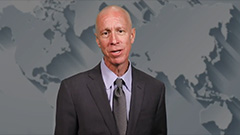
0:02 to 0:04 -“Hello Marriott Associates”; Who is it for?
The message from the onset articulates, who is it for?
The message is posted on public platforms like Twitter and LinkedIn. So rather than just saying hello, Arne chooses to say:
“Hello Marriott Associates”
I have also noticed PM Lee adopt the same style for his recent crisis communications, where is always start with, ” Hello fellow Singaporeans”.
Lesson: If your video will be posted in a public domain please specify who is it for. A video message that aims to address everyone, actually addresses no one.
0:04 to 0:10 – What is it for?
The next 6 secs or so are spent on clearly articulating what exactly is this video for?
“I am here to give you an update on the impact of Corona Virus or Covid-19 ( he uses both the terms, the term people are familiar with and the official name give to the virus by WHO ) on our business.”
We often fall in the trap of telling the story without articulating the point you will be making via the story. So a clear one line on what is this video for conjures clarity.
Lesson: Within the first min of the video it should be clear what is the message for?
0:10 to 0:14 – Commit to an action in place
In the next 6 secs he establishes they he will not just share the impact of the crisis but also steps they will be taking to manage this situation.
This gives the listeners a clear sense that in this 5 mins plus video I am not just going to hear what is happening but also what is being done as a result of what is happening?
“and the steps we’re taking to respond to it.”
Quite frankly, people are aware of what is happening, granted they don’t have the details or data but they do have a good sense of what is happening. As a result they are more interested in the steps being taken. This is the time for you to declare you have steps in place but there is no need to yet describe what they are as yet
Lesson: Do commit that you will share the steps but don’t start sharing the action plan as yet.
0:14 to 0:21 – Demonstrates Vulnerability
Dr Brené Brown has taught us that vulnerability is defined as “uncertainty, risk and emotional exposure.” Brené says that “vulnerability is the birthplace of love, belonging, joy, courage, empathy and creativity.
Sorenson in his statement:
“because of the profound impact COVID-19 is having on so many of us around the world, this is the most difficult video message we have ever pulled together.”
uses a word of emotion – difficult and as a result demonstrates emotional exposure and for him this becomes the birthplace of empathy.
Lesson: Share how you felt whilst putting this video together. You can be as honest and authentic you need to be. The likability of the leader is not how strongly he holds but how openly he shares. Just like in movies the likability for the hero comes from him going through the struggles, not the triumphs. As I am writing this article I have just witnessed Minister Lawrence Wong in Singapore show vulnerability in Parliament and garner immense love from the nation.
0:21 to 0:41 – Humility and overcome doubts
If you google Arne Sorenson most likely you will see a man who looks very different to the man we see delivering the video message. Even his video interview in Jan 2020, just a couple of months ago in Davos he had a very different look. It is likely people have heard that he was diagnosed with Pancreatic Cancer in 2019 and his bald look may further add to the anxiety of the Marriott employees that in a testing times they don’t have the best version of their leader leading them.
Sorenson in his statement:
Our team was a bit concerned about using a video today because of my new bald look. Let me just say that my new look is exactly what was expected as a result of my medical treatments. I feel good and my team and I are 100% focused on overcoming the common crisis we face. Now let’s talk about that crisis.
In such a situation Arne armours up with humility and promises people he is well and 100% focussed on overcoming the crisis. All doubts out of the way.
SECTION 2 : MAIN MESSAGE
0:42 to 1:08 – Demonstrates Empathy
Empathy, before he gets in to the key message, he shows concerns for those in difficult times by saying:
“Let’s start with the health challenge itself. Across our company, the number of covid-19 infected associates is low and I’m grateful for this. I want to acknowledge the associates who are dealing with it as a patient, a parent, family member or friend and the hundreds of Marriott colleagues who are at this minute quarantined. Our well wishes and thoughts are with all of you.”
Lesson: For those communicating on crisis or otherwise. It is not wise to ignore what is topical especially when it directly impacts those you are addressing. It is also interesting to note that at 1.05 mins, he makes a little error. Instead of saying well, he says will, but despite having the option to edit it out, it has been kept. This is a great example of dumping perfection. It’s ok to make little mistakes and that is what makes us human.
Talking on videos is going to be a new normal for many of us and our desire for perfection will serve as shackle in our ankle. Videos are a new face to face communication. It is worth noticing that many will not even notice the mistake, only because I have watched the video several times in an effort to decode it, I have been able to pick on it.
1:08 to 2:02 – Establish the magnitude of the situation
Sorenson establishes the magnitude of the problem not just by saying its bad and using the crutch of numbers and data but by comparing it to other world renowned crisis.
Sorenson says,
“COVID-19 is like nothing we’ve ever seen before. For a company that’s 92-years-old—that’s borne witness to the Great Depression, World War II, and many other economic and global crises—that’s saying something. But here are the facts.. COVID-19 is having a more severe and sudden financial impact on our business than 9/11 and the 2009 financial crisis—combined…In most markets, our businesses is already running 75% below normal levels… The restrictions on travel and required social distancing is having an immediate impact by depressing demand for our hotels.”
Lesson: It won’t be enough to say, we have crisis and this is what is happening but compare it to other crisis that are well known. Statistics are useful but rarely meaningful on their own. They need a comparison with another situation
2:02 to 3:22 – Important information not sugarcoated and taming the possible grapevine
In this section Sorenson continues to talk about the steps they are taking with the key focus on the:
1) Why we are doing what we are doing
Cause: The principal challenge we face is obvious. Governments all around the world are taking the steps to contain covid-19. The restrictions on travel, gatherings of people and required social distancing is having an immediate impact by depressing demand for our hotels.
Effect: As a result, we have hotels around the world that can’t operate without incurring substantial economic losses and risking permanently their ability to reopen when this gets behind us. This has caused hundreds of hotels close or start the process of closing until such time as demand begins to return.
2) What exactly are we doing?
“We’ve work to take controllable costs out of the business like suspending all non-essential travel. We have paused all new hires with the exception of a small number of mission-critical positions. We have stopped all hotel initiatives for 2020 and have gone dark on our brand marketing and advertising during this period. Both Mr. Marriott and I will not be taking any salary for the balance of 2020 and my executive team will be taking a 50% cut in pay. Above property around the world, we are moving to shortened work weeks and in the US, we are also putting in place temporary leave for at least the next 60 to 90 days. That will impact most associates at our headquarters and above property locations. At the property level, contingency plans vary by geography and hotel occupancy rates but for open hotels include closing food and beverage outlets, reducing staff and closing floors of hotels.More details about these actions and what they mean will be shared through local HR teams.”
Taming the possible grapevine: Sorenson ensures he mentions that why we are not taking the same steps worldwide.
“Given the circumstances, we’ve been forced to take proactive steps to respond to the crisis and are putting into place business contingency plans globally. While pieces of these contingency plans vary, given the differences and local laws in the geographies where we operate, certain elements are universal.”
He is aware that in difficult times global Marriott teams will connect and most likely they will talk about the impact they have had. To ensure people don’t feel that the decisions have been unfair and not consistent he mentions it is because of the differences in laws.
Lesson: In this main section of the video, whilst it is important to talk about what the company is doing, it is even more important to start with why the company is doing what it is doing. Secondly, look out for potential rumours that will spread and address them.
3:22 to 3:30 – Trust is built in trenches
In this section Sorenson establishes shared sacrifice
“Both Mr. Marriott and I will not be taking any salary for the balance of 2020, and my executive team will be taking a 50% cut in pay.”
This statement shows that Sorenson is sharing the sacrifice. Announcing that he’s not taking a salary for the rest of the year communicates, we are in this together. Sorenson’s message is clear – if you suffer, I will suffer too, we are in this together.
Lesson : Building trust in the trenches is a hallmark of great leadership, we have seen this same step was taken by Japan Airlines CEO Dr Inamori Kazuo when he announced that he will not take salary for 3 years as he worked hard reviving Japan Airlines from bankruptcy. As a leader, in troubled times, it is not just good practice but a mandatory practice to ask yourself – what is your sacrifice?
SECTION 3 : HOPEFUL END
4:08 to 4:30 – A near success story
In this section Sorenson talks about the early signs of recovery in China.
He makes his narration credible by adding concrete facts. So rather than just saying China is showing early signs of recovery, he says,
“China is bringing manufacturing back.”
Lesson: Make sure there are examples attached to your statements that make your statements a long more credible.
4:50 to 5:05 – Authentic Peak
Sorenson paused for 2 secs here and that pause was a clear segway between his business like voice stating the facts exactly how they were and shifting in to a deeply authentic and emotional voice.
“There’s simply nothing worse than telling highly valued associates- people who are the very heart of this company- that their roles are being impacted by events completely outside of their control. I’ve never been more determined to see us through then I am at this moment.”
You can literally feel Sorenson’s voice choking at this point. Many of us will make the mistake of calling this a practiced delivery. I am sure this is delivery with conviction not practiced delivery.
Lesson : I’m often asked about tips and techniques to deliver messages better. I have never enjoyed responding to that question because I feel who you are is the best way to deliver. What I have learnt is when you don’t deliver your message well , it is not because your delivery needs work. it is because you do not have conviction in the message you are delivering. You delivery is often dependent on your belief in the message you want to deliver.
At 4:50
Sorenson’s emotions are not just seen and heard but felt.
We spend way too much time thinking about delivery what we should think more about is conviction. If you believe in a message you want to deliver, you will have conviction and once you have conviction your delivery will be great.There is also something very special about this line:
“I have never been so determined to see us through.”
Lesson : Such a statement instills faith in people. We all want to be led by a leader who is passionate and determined. And mostly we are, but mostly these leaders don’t use a clear language Sorenson has used to show determination. You may be determined but we are not going to read your mind and figure that out.
5:05 to the end – A hope-filled ending
“While it’s impossible to know how long this crisis will last, I know we, as a global community, will come through the other side. And when we do our guests will be eager to travel this beautiful world again. When that great day comes, we will be there to welcome them with the warmth and care we are known for the world over…Together we can and we will overcome this and we’ll thrive once again.”
My 12 year old daughter introduced me to this beautiful quote by Hal Lindsey:
“Man can live about forty days without food, about three days without water, about eight minutes without air…but only for one second without hope.”
Hope is more important for our survival than food and water and air. Sorenson is ending his message by tying the ribbon of hope around it. Clearly, if hope is gone all is gone.
Crisis is a spotlight on your leadership brand. Despite difficult times and mostly only bad news to give, you can shine under this spotlight and I hope you will use this spotlight to shine in the most authentic way.
Within this week we will be publishing a your 13 step guide to Crisis Communication.
Stay at home and stay safe!
"I attended your story telling course some time back. And I've enjoyed keeping up my knowledge with your blog. You may not have realised however, that the Whole of Government is implementing Internet Seperation. Hence I'm not able to access the links to read your articles. Could I suggest including a QR code in your emails so that I can use my mobile to scan it and gain immediate access to the article? It would be most helpful"



